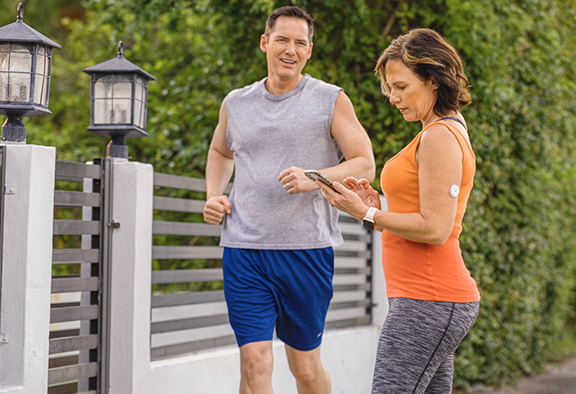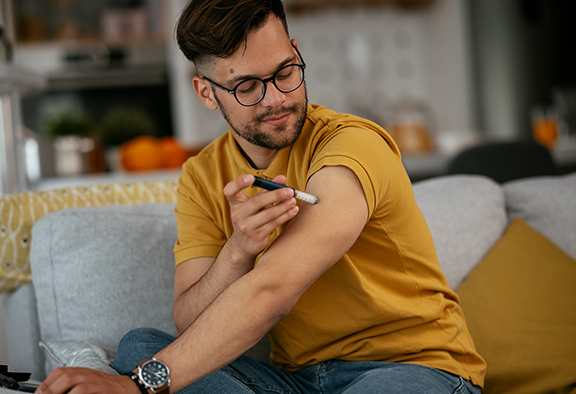September 7, 2022
Diabetes Sweating Connection: Why Does Diabetes Make You Sweat?
Diabetes may cause you to sweat more than usual. Learn more on how diabetes and sweating are connected in the article below.
Share This Story

Life with diabetes comes with many different symptoms, some of which are more well-known than others. Even if you’re familiar with most diabetes symptoms, you may not have known that this condition can make you sweat more than usual.
If you have diabetes and abnormal sweating, you might have lots of different questions – like “Are diabetes night sweats normal?” or “Is sweating after eating a sign of diabetes?” For the answers to all these questions and more, read on.
What is the connection between sweating and diabetes?
Some people with diabetes find it challenging to maintain a steady body temperature. As part of this, they can also have trouble generating the right amount of sweat to cool the body. If you have diabetes and notice yourself sweating too much or too little, it’s essential to take these signs seriously. They can point to problems with blood sugar management or other parts of your diabetes management regimen.
How does diabetes cause abnormal sweating?
Excess sweating can result from stress, cardiovascular issues, or hormonal balance problems. Diabetes can affect all of these factors, so it’s not unusual for people with this disease to sweat too much or too little.
What are sweating symptoms related to diabetes?
Essentially, “diabetic sweating symptoms” refers to any type of abnormal sweating connected to diabetes. That can include excess sweating or not sweating enough.
What are the most common reasons for unusual sweating for people with diabetes?
Type 1
In type 1 diabetes, excess sweating in the upper body is common – but the same situation is less common in the lower half of the body. That’s because people with this form of diabetes often have unusual sweating patterns due to nervous system damage or low blood sugar levels.
Type 2
People with type 2 diabetes also sweat in abnormal ways for the same reasons as people with type 1 diabetes. However, they may be less likely to sweat differently across different body regions.
Types of sweating
A few different forms of abnormal sweating are often seen in people with diabetes. These include:
Hyperhidrosis
When your body starts to overheat, your nervous system is responsible for cooling it down by prompting the sweat glands to start sweating. But since diabetes can cause nerve damage, the nerves that activate your sweat glands might get stuck in the “on” position. That leads to excessive sweating, or “hyperhidrosis.” You might notice this type of sweating:
- In situations like doing small chores or sleeping
- While stressed
- When attempting to get warm by sitting near a heat source or wearing layers
- In cool places
Gustatory sweating
Another type of abnormal sweating closely associated with diabetes is gustatory, or facial, sweating. Along with the face itself, this form of sweating can affect your neck, scalp, and (in some cases) chest.
Gustatory sweating is rare, but just like “normal” hyperhidrosis, it results from diabetic nerve damage. If you have this form of sweating, you may get a red face and start sweating while eating – even if the food you’re eating isn’t particularly spicy.
Night sweats
If you commonly have low blood glucose due to your diabetes treatment program, you might find yourself dealing with night sweats. That’s because low glucose levels (due to excess insulin, the diabetes medications known as sulfonylureas, or other reasons) can trigger the release of adrenaline.
The good news is that night sweats should go away when your glucose levels get closer to normal. While blood glucose control is the best way to avoid night sweats, you can also lower your risk of this type of sweating by not:
- Exercising right before going to bed
- Taking some kinds of insulin in the evening
- Drinking at night
What are the affected areas?
Sweating related to Diabetes can affect almost any part of your body that usually sweats. That can include your underarms, hands, feet, face, chest, and neck.
What are my treatment options for excessive sweating?
If you suffer from excessive sweating as a result of diabetes, there are a few different treatment options available to you:
Procedures
- Botox injections
- Certain types of surgery
- Electrical current therapy
Medication
- Anticholinergics (nerve-blocking medications)
- Antidepressants
- Clinical-strength antiperspirants
Causes of low sweating in people with diabetes
While this article has primarily focused on excessive sweating up to this point, people with diabetes are also susceptible to another sweat-related issue – that is, not sweating enough. The inability to create enough sweat is called “anhidrosis,” and it can make maintaining a suitable body temperature in hot environments difficult.
When diabetes is to blame for anhidrosis, the cause is very similar to that of hyperhidrosis. However, in anhidrosis, the nerves responsible for activating your sweat glands are stuck in the “off” position. Since people with type 1 diabetes often sweat more than normal in the upper body and less than normal in the lower body, they are especially prone to this condition.
If you suspect you are dealing with anhidrosis, look out for these common symptoms:
- Little/no perspiration
- Trouble staying warm or cool
- Finding it difficult to cool down after physical activity – even minor activity
- Getting overheated easily
- Dizziness
- A flushed face
- Fast heartbeat
- Muscle cramps/weakness
- Nausea
What lifestyle changes can help with sweating related to diabetes?
Along with the procedures and medications described above, there are a few lifestyle changes you can make to deal with abnormal sweating and diabetes:
Wearing the right clothes
When you need to manage the effects of excess sweating, the clothes you wear matter. Wear natural fabrics like cotton instead of synthetic alternatives, and look for sports clothes made with “wicking” fabrics that can take moisture away from your skin.
It’s also crucial to make sure you’re changing clothes regularly. Switch your clothes on at least a daily basis, and avoid wearing the same shoes daily. On the topic of shoes, wearing open shoes and ensuring your feet get enough air can help you avoid sweaty feet.
Staying cool if you can’t sweat
On the other hand, you’ll need to actively control your body temperature if you’re dealing with anhidrosis. Steps you can take towards this goal include:
- Not doing intense physical activity when it’s hot out
- Adjusting your home’s room temperature, if possible
- Taking cold showers
- Drinking cool water and other fluids
Controlling your blood glucose
Since blood sugar levels can directly affect your likelihood of experiencing night sweats, the best way to deal with this type of sweating is to do everything you can to stay in range. (Even if you’re dealing with another form of sweating related to diabetes, controlling your blood sugar is still a good idea.)
You’ll need a few different things to keep your blood glucose in check. First, you’ll want a high-quality blood glucose meter and the supplies to go with it. For added convenience and more information on your blood sugar levels, you may prefer to use a continuous glucose monitor in most situations.
The number one place to get these diabetes supplies and others is US MED. We’ve been active in this industry for well over 20 years – in that time, we’ve been accredited by the ACHC, URAC, and NABP and received an “A+” Better Business Bureau rating. Start enjoying benefits like free priority shipping and automatic reorder reminders by ordering diabetes supplies from US MED today!
Source: https://www.ncbi.nlm.nih.gov/pmc/articles/PMC8502225/








